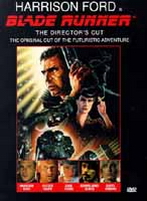| |
|
|
|
|
|
| |
1. |
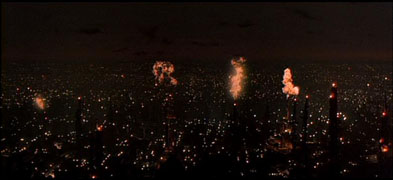 |
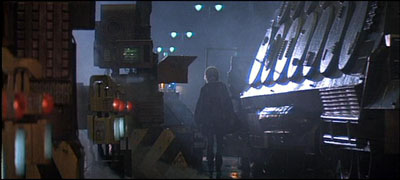 |
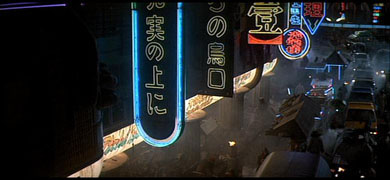 |
|
| |
Elaine Chau
Comment on the environmental state of L.A. in 2019? How does the
state of the environment in this film contribute to a specific reading of the metropolis of the future?
The film portrays L.A. as a machine driven society. The future of L.A. in 2019 is not possible without the help of machines. Buildings are indistinguishable from one another within the metropolis. The massive high density complex called the ‘Tyrell Building’ governs the landscape. Occasionally, fire spits out into the sky – this is an indication that technological progress never sleeps. For a majority of the film, the atmosphere is very cold, dreary and dark. When experiencing the film, it is difficult to get a good reading of time because one is never able to experience a true transition from light to dark. This is probably due to the heavy pollution that surrounds the city as a result of technological advancement. It also suggests that the cycle of time has lost all meaning and time itself becomes indeterminate in a society that is so fast-paced.
Natural light is only visible at the very top of the Tyrell building, within the personal living space of Dr. Tyrell. Dr. Tyrell is seen as the god-like figure that controls the city. This condition is similarly expressed in Fritz Lang’s Metropolis where the working class live in the subterranean realm and the upper class oversees the city. The tensions between the classes are clearly shown by their respective environments. The places at grade are old and decayed, almost in an unliveable state. The high-tech architecture is revealed within the dominant building complex.
The future of L.A. is a true dystopia. The society focuses on consumerism – large billboards and signage fills the streets. The streets are always congested with vehicular and human traffic due to poor design and the fact that the city is overpopulated. The emphasis of information processing is also a dominating aspect that structures the society. People are not really given the opportunity to think for themselves. Everyone appears to be in a state of paranoia because nothing is what it seems. The Tyrell building is the only anchoring element. Control within the society is very prominent as there is a strong presence of the law wherever you go. The environment is devoid of any natural life so people begin to lose the sense of what is natural within their own lives. People are caught up with the complexities of their own lives that everything becomes individualized, even public space itself. Even though people live collectively, the sense of belonging within a collective remains absent. As a result, places have become nameless and obsolete.
|
|
| |
2.
|
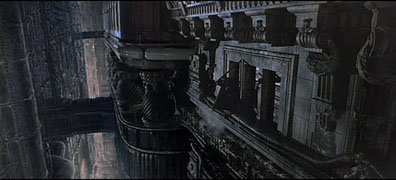 |
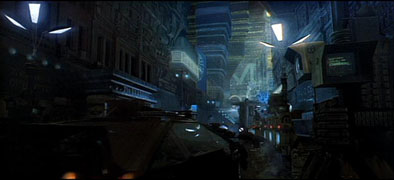 |
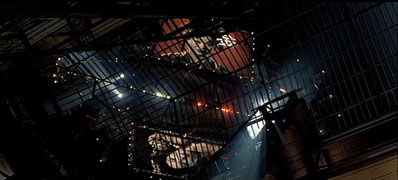 |
|
| |
Anne Cheung
Comment on the technique of blending existing streetscapes with animated/model
environments? How does this impact the creation a futuristic urban environment?
The blending of the two environments demonstrated a surrealistic environment and two contrasting atmosphere in the movie. The computer-animated scenes have a lot of references from Japanese manga/animation, ie. the spacecrafts, the metropolis surroundings and even the huge flying screen with a Japanese woman singing in her traditional costumes, all of these resemble scenes or moments in Japanese sic-fi animations. Things are over-exaggerated to bring a more powerful impact on the idea about future technology. The renderings are done realistically with high attention to details. On the other hand, the existing streetscape is a portrait of a decayed city from the street level perspective. In order to blend the two different environments together smoothly, the whole film is set in darkness, gloominess and rain. In my opinion, the boundary between the real and unreal has never really been fully resolved, both physically and experientially. In Bladerunner’s metropolis, the street level seems to have been abandoned by civilization. The darkness, gloominess and wetness all contribute to make the futuristic city a mysterious place to be. Buildings are non-occupied or have fallen apart, roads are not well maintained, and people just seem to be disorganized. On the other hand, the upper level of the city (animated towers) is much more civilized. The urban environment as a whole is in between a transitional stage from a present metropolis into a futuristic one.
The beautiful renderings never look like they are suitable in the existing urban context, they don’t sit on the ground, and they seem to float. The tall towers are always shown in the background in the sky or from and aerial perspective, but they have no connection with the street level at any extend. There is no sign of how one could get up a building from the messy and crowed street level. The combination of the two gives the audience a strange and awkwardly contrasting feeling. The technique of blending the two environments is appreciated, however, the weak relationship between the two is a bit distracting.
Personally, I think the impression of the abandoned streetscapes, builds a disappointing futuristic city. The urban environment is not longer about architecture, culture and urban connections, the city have just been over-powered by the interests in new technology. However, the technique of combining animations and real streetscapes does intensify the believability. It easier for one to really feel the existence of the spaces by showing things that is familiar to the subconcious, which allows the audience to quickly relate themselves and their memories of the experiences in an urban context to the movie.
|
|
| |
3. |
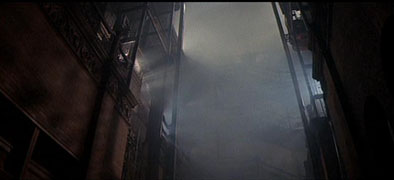 |
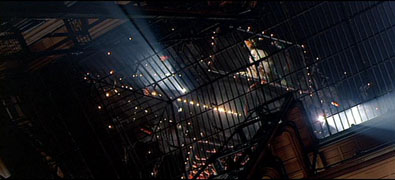 |
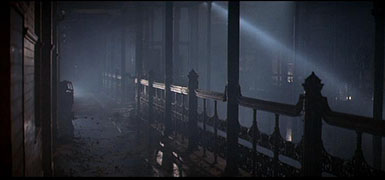 |
|
| |
Andrew Dadds
Talk about the transformation of the interior of the Bradbury Building?
More or less effective than a completely artificial environment? How
does the adaptation of a real building (that many people might actually
recognize) alter the success of the use of architecture in the film?
The use of the Bradbury building in Blade Runner speaks to the over theme of temporal layering in the architecture of the film. Ridley Scott used the technique of retrofit in order to blend architectures; the future is presented as an amalgamation of past periods. As such it is radically believable, instead of a totally new architectural fantasy, buildings such as the Bradbury are incorporated and presented in a new way through a kind of gritty affinity between the existing world and new atmospheres. Ridley Scott first uses the idea of desolation in order to alter the reality of the building. As a building well known to television, the total extraction of human activity gives the building a kind of surreality. Coupled with juxtaposition of intrusive flying billboards and mix-matched rooms incorporating plaster walls within an otherwise steel building, builds this tension of a surrealist domain. A central theme in Blade Runner is one of memory and artificiality. Without the theme of memory and recognition, the gritty architectures of the film wouldn’t resonate such an affect within its users. Elements such as the Bradbury building and even Frank Lloyd Wright’s Ennis house, give the visionary future an anchor to its viewers. As a result, the “new reality” plays with existing connotations and affinities, strengthening the impact of the film. The architecture in Blade Runner consequently has roots. Even where existing buildings are not incorporated and the set calls for a new design, it makes cultural references to the past; the ziggurat-like superstructures in the film are an example of this. The film then transcends its own artifice, to a new reality that is built on the foundations of the past. … It’s just perfection.
|
|
| x |
4. |
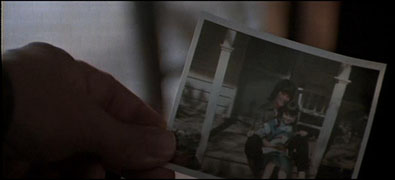 |
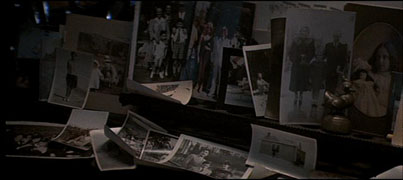 |
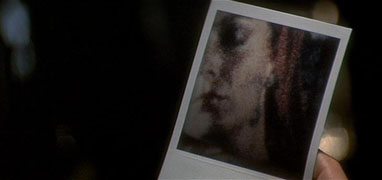 |
x |
| |
David Domanski
Speak about the significance of photographs in the film? How do these
play into notions of false memories and perhaps some surrealist notions
of dreams and altered states of belief or being? How do these connect the film to an understanding of the metropolis of the present?
In the first image, Deckard had just finished proving to Rachael that her memories are implanted, being real memories but false to her. Having come off of this conviction, he sifts through photographs of his passed away family in his apartment. He dwells on these memories, invoking a sense of suspicion. As they are dearly departed his only remaining connection to people who are his family is through memory – a concept that is rigorously interrogated throughout the films narration. It is not only a question of truth or authenticity; the conviction of being human versus being replicant becomes far more imperative. In the second image, Deckard is falling asleep on his piano, which is littered with photos of his family and the people in his past. After a brief lapse in which he dreams a unicorn running through an ethereal forest, he fixates on these photographs. He doesn’t find himself in any of the photographs – the images lack evidence of his relation to the people he knows to be his family. This alludes again to the concept of implanted memory. The third image follows right after the second. As Deckard wakes he snatches a photograph of Leon’s room from the piano, puts it into an image processing machine, and tracks onto an image of a woman captured in the reflection of a bathroom mirror. He believes he has discovered another of the renegade replicants. This association was made only by means of new technology, implying a new realm in which the boundaries of privacy and secrecy are invaded. What is becomes apparent is the remodeling of nature and reprioritization of life rituals affected by modern progressive technologies. Photographs in the film provoke a criticism of the modern metropolitan obsession with identity. It explores the ambiguity of historical roots, of relations versus associations, the difference between metaphor and simile. It experiments with the power of association in an image, while on another level interrogating the possibility of false associations.
|
|
| |
5. |
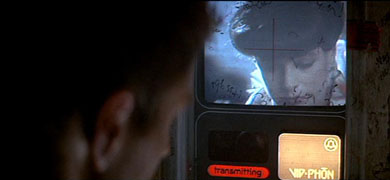 |
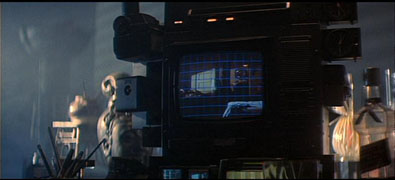 |
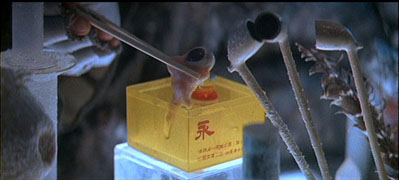 |
|
| |
Mark Kim
Talk about the state of technological gadgets in 2019? How does this
compare with the technologies presented in Metropolis 1927 Things to Come?
Given the date of the film being 1982, do you think Ridley Scott went
far enough with these in order to support a metropolis of the future?
Many science fiction films visualize the future by projecting the trends of that time period and enlarging it. Both Metropolis and Blade Runner takes visual cues from the time period to create the fictional future architectural scape. Especially in Blade Runner, many of the settings are filmed in real locations with little modifications, such as the building that FJ Sebastian lives in or the interiors of the police headquarters, which are both prominent existing buildings. In Metropolis, we see the prevailing art deco style dominating the architecture above ground with reference to neo-classicism. One thing that separates Blade Runner from Metropolis, or in fact most other science fiction films made until that time, is how restraint the technological aspect is shown in Blade Runner. While many science fiction films create the feeling of future by having absurd gadgets, contraptions and machineries, such as the mechanics of the underground world in Metropolis or the equipment in the mad-scientist’s lab, Blade Runner focuses on more of the philosophical questions of the movie rather than trying to convince people that it is set in the future. Many of the technology and architecture we see in Blade Runner are believable just because they are not that much different than the current technology at the time. And that allows people to connect to the film much more easily (as it does not seem so alienating), and focus more on the philosophical question of whether androids are human, and what is to be human. However, this is not to say that Blade Runner was lacking in its vision of the future. There are many restrained yet sophisticated technology that is portrayed in Blade Runner. The snake scale that Deckkard finds in Leon’s apartment shows how technologically advanced the LA of 2019 really is. When he takes the scale to an expert, we can see how it is not only an artificial scale but is made with extreme precision, to the level that we see a serial number that has been microscopically engraved on the surface. Many of the technological advancement we seen in Blade Runner are bio-science, whether it is the artificial animals to Chew’s Eye lab, and finally the Nexus 6 models who are in every way human except for their lack of emotions and short lifespan. Through this, we can see how careful and precise Ridley Scott was in filming Blade Runner, to balance out the sophisticated technological advancement with the importance of the questions raised in the film, so to not dilute any of the important aspects away by showcasing wacky and odd technological gadgets but still giving us a highly sophisticated details of the future.
|
|
| |
6. |
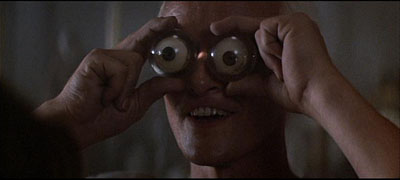 |
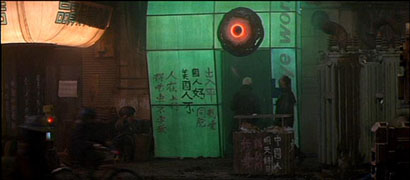 |
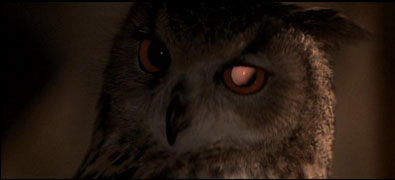 |
|
| |
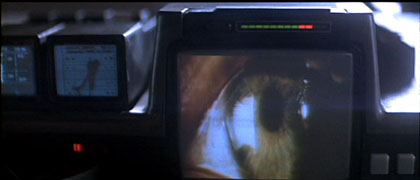 |
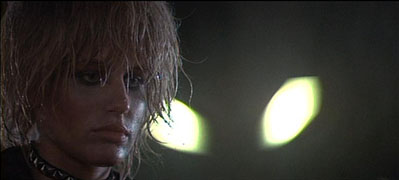 |
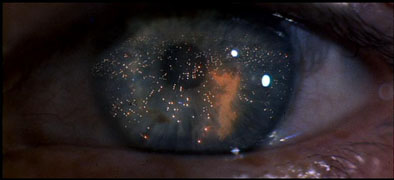 |
|
| |
Peter Kitchen
Significance of Eyes? Why do they play such a large part in the film? How do they support the presentation of the urban future?
In Bladerunner the eye is a window to the soul. They use the eyes to test replicants on an emotional and body language level. By measuring the fluctuations of the pupil and unintentional dilation of the iris when asked about their past and memories, Deckard can determine if they are a replicant or not. He is able to see beyond their fake façade and into their identity. In this sense the eye not only perceives our world and takes in an abundant amount of information but it also gives away a large amount of information. It could be argued that the eye, in the case of Bladerunner, the eye is the most important organ in the body for it holds identity.
The role of eyes also comes up continually and subtly during Bladerunner. Roy and his companion visit the genetic engineer who created their eyes and he ironically points them in the direction to Tyrell. Tyrell, by wearing large thick glasses, re-enforces his reliance on technology as a source of his power and knowledge, however Roy later in the film pushes Tyrell’s eyeballs in with his thumbs.
In a direct relation to the audience, eyes play a part of the film because of the slight glow coming from the eyes of replicants that can be seen in a variety of scenes. It gives a hint to the audience as to who is a replicant and who is human. It also ties together an idea of what is real, copied or replicated in both a human sense and an urban one.
Eyes support the presentation of the urban future by calling into question its reality as well as our ability to perceive that reality. The urban future as depicted in Bladerunner is littered with advertisements for off-world colonies, replicants and parcels of high-tech environments as well as old, decaying city blocks with no clear barrier between them. It is impossible to tell what is old and what is new. Where the past ended, the present is, and the future begins. We are unable to perceive it, unable to see beyond the fake façade. As with replicants and humans, the only way to perceive the difference is through the eye.
|
|
| |
7. |
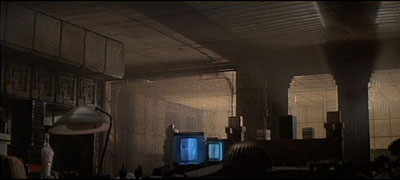 |
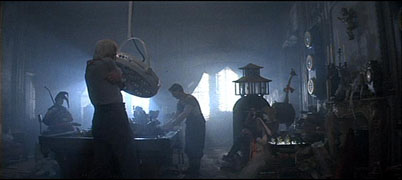 |
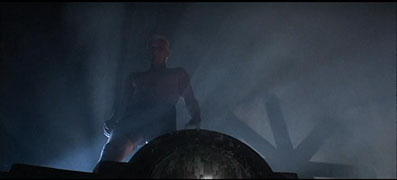 |
|
| |
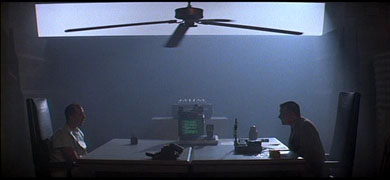 |
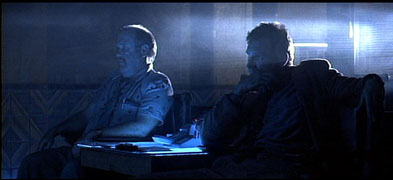 |
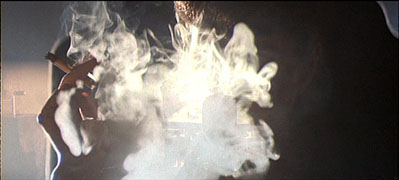 |
|
| |
Renee Lu
Source and effects of indirect lighting to illuminate most scenes?
How does the lighting in the film contribute to an atmosphere that might
be: dystopic? fearful?
Generally speaking, the Blade Runner is a dark movie with a large amount of opacity in vision. Light is selectively sliding into the scenes and intentionally manipulated to achieve certain effects. Overall, it contributes to a dystopic and fearful atmosphere.
Steven Poster is an outstanding Director of Photography who did the additional photography to Blade Runner. When he talked about light in filmmaking, he mentioned that the type of light (direct or indirect) and the angle and distance of the source should be articulated to bring out expressive qualities of the object. [http://www.davidbordwell.net/blog/?p=6885] In the plot, the only glimpse of the direct light from the sun happens in Tyrell’s office through the gigantic window. Since the sun has been control by Tyrell Corporation as an instrument serving the dark force, the sunlight appears gloomy and ghastly to harmonize the rest of the scenes.
All six images above are taken from the scenes in an enclosed space with indirect light coming from one direction. In image 1, 2 and 5, the rooms are structurally deep. The diffused light comes through the windows or lighting fixtures at the far end of the rooms. The cameras are placed at the other end of the rooms facing the direction the light coming in. technically, this type of placement allows enough light coming in the camera while shooting a dark space; emotionally, it forms a contrast between outside and inside which emphases the darkness of the inside space. The choosing of diffused light instead of direct light not only gives us a sense of the dystopic outside world, but also helps to construct the inside atmosphere into a depressed darkness.
In image 3, the angle of the light plays an essential role in presenting the power of the human figure. There seems to be several projector lights behind the figure which come from a lower lever and travel foreupward through the figure. Since the figure is back lighted, he appears in totally darkness. The light intersects behind him to form a focus of the scene which creates a kind of mysterious power. Also in image 5, there are two light sources: one is the light from the far end of the room, and the other is the light coming through the lighting table. Without the lighting table, the faces of both figures will not be seen in the darkness due to the backlight (same to image 3). But different from image 3, here the director wants the figures to be seen by the audience. So, the table is lighted intentionally to light up the faces. The light comes upwards from the table to the faces which makes them look ghastful.
Blade Runner is an excellent movie in terms of light setting. Steven Poster said he re-watches the film over and over, and each time he finds something new. On his last pass, in the scene of searching Kowalski’s apartment, Steven noticed the light coming from the desk drawer calling for attention to the newspaper inside it.
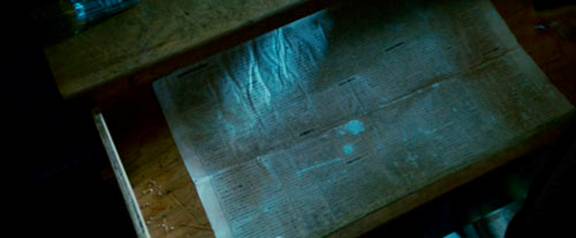 [http://www.davidbordwell.net/blog/?p=6885] [http://www.davidbordwell.net/blog/?p=6885]
|
|
| |
8. |
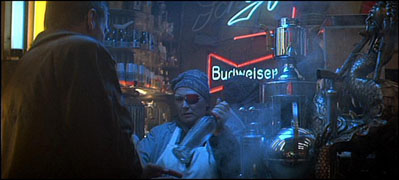 |
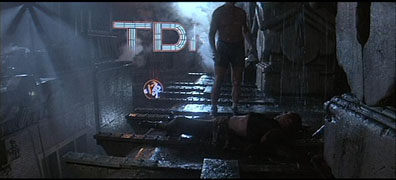 |
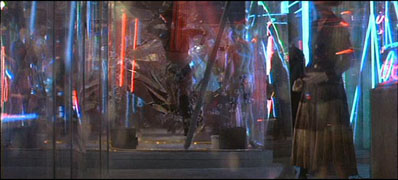 |
|
| |
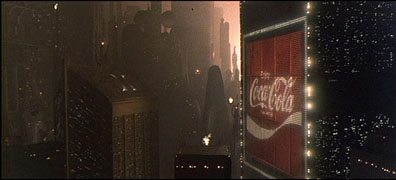 |
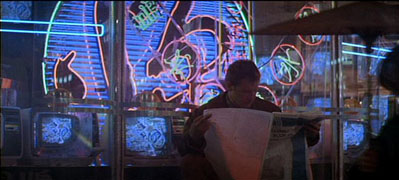 |
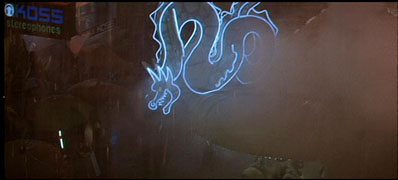 |
|
| |
Andrew Ng
Use of neon/signage? How does this affect the life and environment
of the metropolis portrayed in the film?
From the images shown, the neon signage is very dominant in the city. In fact, very little light exists in the metropolis of future 2019 Los Angeles. In many of the street areas on the ground level, the neon signage serves to be one of the major sources of light in the city. Even the umbrellas have glow-sticks which light up to provide light for the user.
While today we use neon in reserved amounts to attract attention to certain things in stark contrast to normal lighting. Colours and types of signage used today in conjunction with conventional lighting are very different from the ones shown in Bladerunner. In the movie Bladerunner, the neon signage is very prevalent, from storefronts to windows to even decorations. In the first image, the signage is not unlike what we see today, common advertisements in a store which only direct your attention to it for a moment. These are less dominant and less demanding in terms of the attention they draw, but they also seem to provide light behind the bar as the light is reflecting off a lot of the reflective surfaces.
In the second and third images with the TDK and CocaCola signs are very large and dominant signs that advertise towards many individuals. While these do not really provide much light towards the metropolis’ inhabitants, they provide the light for the city skyline and define the cityscape. These large icons serve to be beacons, landmarks, and even monuments in the future metropolis.
The fourth and fifth images, both storefront, show more loud and obnoxious neon signage which is extremely dominant and demands much attention from the inhabitants. These begin to take the attention of the inhabitant away from the city and from the interactions between others, but rather on the retail and the advertisements that exist. These bright lights light the city and also detract the attention of the inhabitants away from the urban interactions of the contemporary city.
The filming of the lighting also helps contribute to the atmosphere portrayed in the world of Bladerunner, with a very dark environment and extreme contrast for the neon lights. This helps to show the mood that is set in the city, but also show the stark contrast between what is advertised and what is mundane. The final image of the dragon shows the Asian marketplace with everything dark and simply juxtaposing the blue dragon. This juxtaposition enforces the impact of the neon lights and the advertisement of the metropolis in Bladerunner.
|
|
| |
9. |
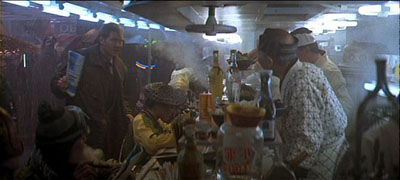 |
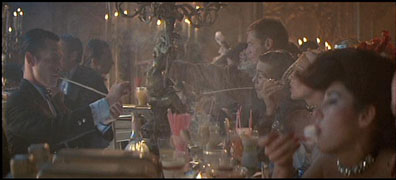 |
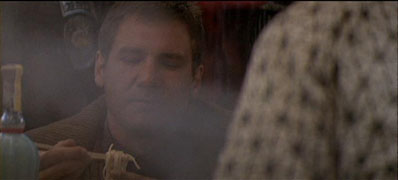 |
|
| |
Connor O'Grady
Concept of food and eating? How does it affect the portrayal of
both the plot and the reality of life in the metropolis of LA in 2019?
Throughout Blade Runner the concept of food and eating is expressed through a fast food, high-density environment. The eating spaces are often crowded and loud and are public areas. Deckard is seen eating by himself and is seen eating with disposable cutlery. The concept of eating loses its position as a social, symbolic and traditional moment within the day. The city envelops the place of eating in favour of activity. Also, the food does not seem to be any different than that which is eaten today. This also emphasizes the roles of traditional food styles and even though the city changes even if the ritual of eating becomes severely modified. The role of domesticity within blade runner as a place of cooking is nonexistent.
This is an interesting method of displaying the ideas of eating because not only does it represent a vision of high density living, as a city that is constantly working and moving, and people are out and about, it also uses traditional eating as a means of creating pause within the movie in order to maintain particular realities within a Sci-Fi setting. The eating styles is quite similar to that of current day Tokyo or Hong Kong which makes it relatable to the viewer about the possibility of the portrayed version of L.A to be one of the future. Additionally, it is an important role in blurring the boundaries between Replicant and human. If the Replicants did not eat or sleep they would clearly be easily identifiable against the human race. However the need for nourishment becomes a key role in the illusion of Deckard’s character about whether or not he is a Replicant.
The second image defines an interesting scene in this relationship as Deckard leaves without getting his food in order to pursue “the lady with the snake” This scene shows the reality of having to wait for ones food in a busy place, however it becomes a hint of the priorities Deckard has of eliminating the target over eating, when his food would have been there only moments later. Therefore in this moment, food is no longer a need for him. Mind you, it is still a byproduct of the metropolitan city of the future which favours the importance of activity and work over the ritual of eating.
|
|
| |
10. |
 |
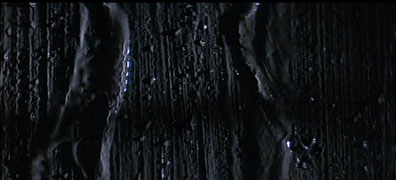 |
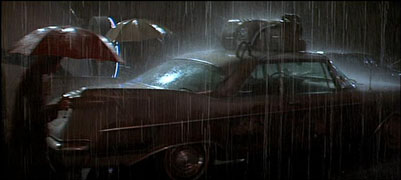 |
|
| |
James Strong
Rain/water + darkness???? We see quite a different environment here
than in other films. How is it being used to increase the feeling of
unease or discomfort in this film? Would this film have the same impact
without the constant wetness? How does it impact the idea of the metropolis?
There is a certain feeling of unease and discomfort comes from the notion of being wet. When it’s raining people are constantly trying to escape from the water – hiding under overhangs, holding umbrellas, running to their cars. The movement of people when it is raining also adds a sense of urgency to the pace of the film, there is an inherent need for people to stay dry. Scott is making an attempt to bring this feeling of unease past the narrative of the movie and into its very environment. In each space we’re confronted with some notion of uncleanliness, darkness or dampness– Deckard’s apartment, the streets of LA, the Tyrell Co. headquarters, the abandoned hotel – it literally permeates every set in the film and contributes to the notion that this discomfort is absolutely inescapable.
The atmosphere of the film is also a reflection of Deckard’s mental state. The audience (and Deckard to some degree) are faced with the moral issue of Deckard’s job – how human is human? Do the authorities actually have the right to ‘retire’ these creations (which have more in common with clones than machines)? The literal darkness of the film reflects the moral darkness of Deckard’s task, and the fogginess of most of the sets reflects the clarity with which Deckard understands the replicant situation. As the movie progresses Deckard’s relationship to the replicants is one which recognizes them as increasingly human – to the point of his sparing Rachel despite the fact that she is added to his kill list.
At the level of the films creation the constant rain and water in combination with the general darkness creates a great texture for the streets of LA. The harsh lens flare of overhead spotlights or passing vehicles reminds the audience that we have been relegated to this underground and that our eyes are not at all adjusted to the light. The reflections of bright light off the pools and puddles in the street are really what give the space of the sets any depth. I would suspect that on some level Scott would have been unable to film a dry set as successfully as he was a wet one. The subtle shapes of the architecture of the set would have been undefined; but with the simple reflection of a wet sheen the audience is able to understand some sense of texture even in the darkest of Bladerunner’s sets.
In this regard the audience view of the LA metropolis is a place in which we don’t want to be. It is wet, dark, crowded and uncomfortable. It is made clear within the films narrative that majority of the population has moved to off world colonies and so earth has become in a certain sense neglected. The metropolis that we experience in the film is not intended to be a place for people to inhabit, it is intended to be a centre of industry (note the size of Tyrell’s headquarters, the flaming towers that inhabit the skyline of the opening scene). The discomfort of the constant rain and dampness affects our desire to get off-world.
|
|
| |
11. |
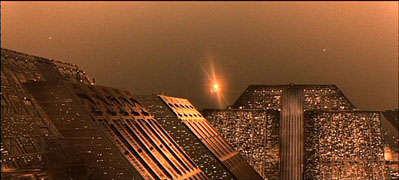 |
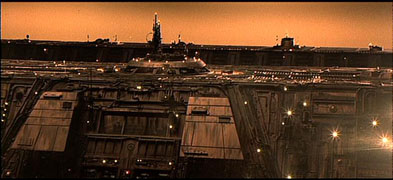 |
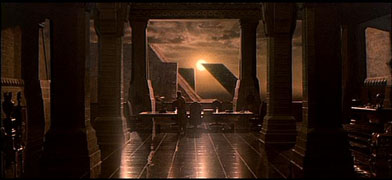 |
|
| |
Eric Tai
The architecture of Tyrell Corporation's Headquarters?
Compare this to the type of architecture used in Metropolis 1927.
Speculate upon the floor plan for these massive buildings? Issues like
distance from windows? What is it like to be "inside" these
buildings? Do you think this aspect of the reality of the buildings
proposed is lost on the general public? Do you think it really matters? How does it affect the portrayal of the metropolis?
|
|
| |
12. |
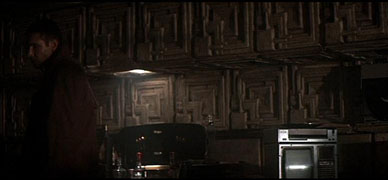 |
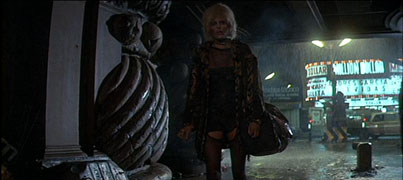 |
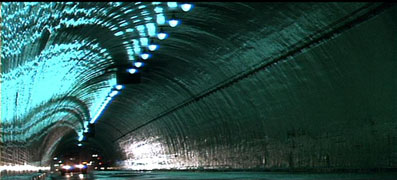 |
|
| |
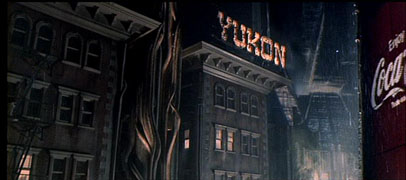 |
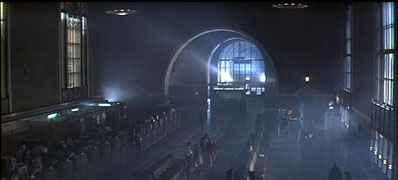 |
 |
|
| |
Bei Wang
Use of significant present day L.A. Buildings in an identifiable
form? How does this affect the believability of the
film?
The film Blade Runner, like Metropolis, defines the dystopian movie genre. Like in Metropolis (1927), it creates an image of the dystopic future through a projected representation of the metropolis. However, the difference between them being that where Metropolis constructed a set which is imagined for the purpose of the film, Blade Runner’s projection of the future indicates a certain continuity with the image of the present through the use of identifiable present day architecture. This, I believe, helps emphasis the dystopian nature of the film by projecting existing trends along their current downward trajectories - mainly the decay of urban environment.
Throughout the movie, several recognizable landmarks in Los Angeles, such as the Pan-Am Building, the Bradbury building, Union Station and even Frank Lloyd Wright’s Ennis Brown building were all appropriated for the film.
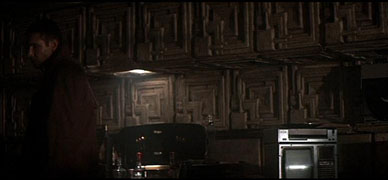 The theme of repetition continues as the Ennis Brown building gains an extra few hundred storeys in this new context where safety, security becomes associated with power and social standing, and power is directly related to the scale (size and height) of the building which one occupies. The Tyrell Headquarters, stands as a symbol of power, a soaring tower in the sky where businesses are conducted within the calm security of the interior. Way below on the ground is where the social outcast are trying to scrape by a living in a dark, oppressive, dirty streetscape, a theme consistent with those portrayed in Metropolis (repetition and height with respect to power). The theme of repetition continues as the Ennis Brown building gains an extra few hundred storeys in this new context where safety, security becomes associated with power and social standing, and power is directly related to the scale (size and height) of the building which one occupies. The Tyrell Headquarters, stands as a symbol of power, a soaring tower in the sky where businesses are conducted within the calm security of the interior. Way below on the ground is where the social outcast are trying to scrape by a living in a dark, oppressive, dirty streetscape, a theme consistent with those portrayed in Metropolis (repetition and height with respect to power).
The interiors of Deckard’s house is presented as a typical and conventional house which contains recognizable elements of in the style of the age (such as the microwave and TV). And although the voice activated technology has been added, the physical form of the object has not changed, the only difference being that the environment has changed, the presence of natural light and life forms has been replaced by cyborgs and endless skyscrapers. This conventional lifestyle provides a contrast to the deteriorating urban living conditions outside. It is perhaps Ridley Scott’s intention to emphasis the potential for decay that is already present in the contemporary urban life through this contrast of the inside-outside.
The use of recognizable interior and exterior spaces within the context of a deteriorating urban fabric portrayed in the film Blade Runner alerts us to the dystopian nature of Metropolitan life by projecting it as a continuity of the present.
|
|
| |
13. |
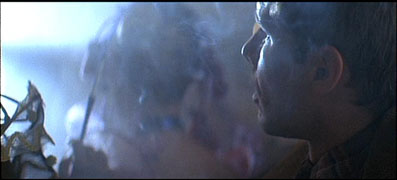 |
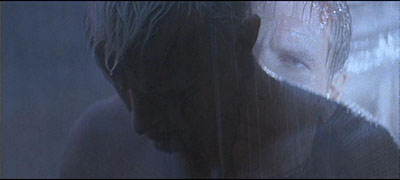 |
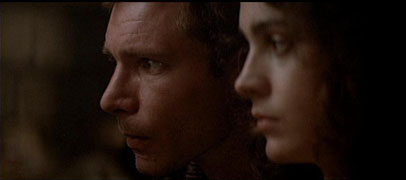 |
|
| |
Stephen Wenzel
Use of changing focus/depth of field? How does this change the ability
to create more subtle shifts of attention or increase detail in the film?
Compare this to earlier methods of creating specific facial focus that
we have seen.
The use of changing of optical focus as a filming technique in “Blade Runner” has a major impact on the focus of the viewers and the subtleties they can read in a scene. The three images, providing examples of depth of field, focus in on the characters faces, leaving everything in the background as a relatively indistinguishable blur. As a result, the details of the characters faces are really drawn out and their emotions are quite clear. This technique lets the viewer know that nothing else in the scene is important compared to the inner struggle that the character is going through and allows the viewer to read the character’s thoughts on their face. The first image is taken from the scene of Deckard at the bar in search of Zhora, the snake lady replicant. The focus is on the subtle changes in Deckard’s reaction as he realizes he has found his first target. The lack of visibility into the rest of the scene as well as the bright out-of-focus light brings a sense of mystery and suspense leading up to Deckard’s encounter and pursuit. The second image shows Roy, the leader of the rebel replicants, giving up his last breath after sparing Deckard’s life. The focus only on his face brings the viewer into the pain and regret for death, which he is experiencing. As the image gradually goes more and more out of focus, the light brightens giving him a soft, almost angelic appearance. Deckard seems to sympathize with Roy in this moment, and through this imagery, the viewer can to. The third image is taken at the piano just before the love seen with Deckard and Rachel. Depth of field is used to eliminate all distractions from the scene and leave just their two faces illuminated in the darkness. A certain emotional intensity is brought to the scene and the subtleties of their facial expressions drive the acting.
In comparison, earlier methods of creating specific facial focus involve little subtly and instead employ a great deal of exaggeration. Instead of using depth of field to subdue the rest of the scene, films from the 1920’s and 30’s such as “Metropolis” and “Things to Come” used make-up and expressions to make the characters’ faces stand out above the rest of the scene. This technique is illustrated in the over exuberant faces of Maria and Freder in “Metropolis”, especially in the enactment of fear. In terms of cinematographic techniques, when the filmmakers of this era isolated one person’s face, it was often centred in the field of view to ensure it was the focal point. An example of this is seen in the monologue of the crashed pilot in “Things to Come”. The historical methods of creating facial focus tend to seem staged and theatrical in comparison to the use of depth of field, which allows the actors to tell the story with subtle and emotional gestures of the face.
|
|
| |
14. |
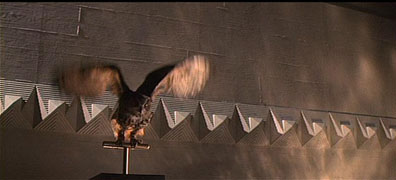 |
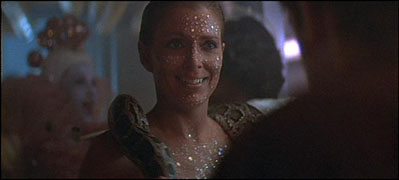 |
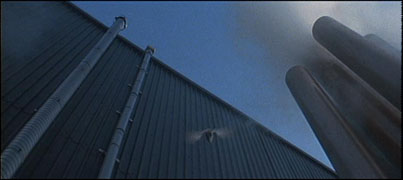 |
|
| |
Lisa Wong
Reference to live animals? How does this impact our reading of the metropolis of the future? Can this be translated into more architectural terms or inferences?
All of the animals in Blade Runner are genetically engineered (Replicants). It is implied throughout the film that real animals are extremely rare or extinct. This is evidently due to the control humanity has on the city (or planet). Human progress has developed to such an extent that all of nature has been eliminated, only to be replaced by human creations – building, infrastructure, and Replicants. The result is a metropolis that is cold, dark, hostile, and nearly inhabitable if it weren’t for human technology.
The animals depicted in the film are symbolic, and do well to represent the metropolis and the people who have created it. Among the animals shown include the owl and the snake. The owl belonging to Tyrell represents the ingenuity of the human race as well as the life of the metropolis. Like the owl, the people of the futuristic Los Angeles come alive at night rather than during the day. In fact, the day never seems to occur in the city or on the planet, and if it does occur, the buildings always block it out some way or another, as if sunlight (or any light) is unwanted and unpleasant. The metropolis may also be represented by the snake, a symbol for deceit. The city is deceiving in that although it appears to be and is technologically and architecturally advanced, much of it is in poverty, particularly on the ground level. Also, the ambiguity between day and night plays a role in heightening the sense of paranoia experienced by the characters and the viewers during the film. For example, the interior of the buildings are never well lit – naturally or artificially – which amplifies the sense of constant darkness, fear, and uncertainty.
The references to animals also play an important role in gauging humanity. Many of the questions of the Voight-Kampff test refer to animals in order to instigate emotional responses from the Replicants. The Replicants showed the tendency to empathize with the animals in question, and would react very emotionally as a result. The Replicant Rachael, by contrast, has implanted human memories and should there reflect more closely the human condition. During the test, when Deckard makes the supposition “A wasp goes up your leg…” Rachael immediately responds with: “I’d kill it.” Instead of showing emotional empathy towards the animal in question, her response is unflinchingly uncaring. This is to show that humans do not empathize with animals as do the Replicants. Ultimately, this explains why humanity has eliminated all of nature and its animals from its city (or planet). In losing the ability to empathize with nature and all its animals, humans have become cold, uncaring creatures. In essence, they have become less human than the Replicants themselves. Once again, the consequence is a shaping of a metropolis that is equally as cold and cruel as humanity has become.
|
|
| |
15. |
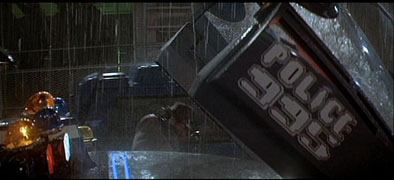 |
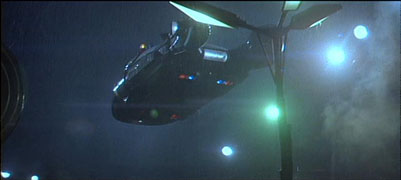 |
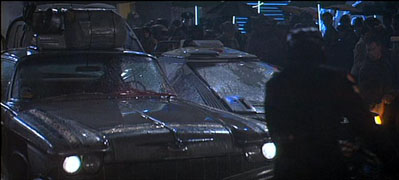 |
|
| |
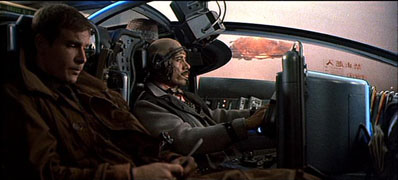 |
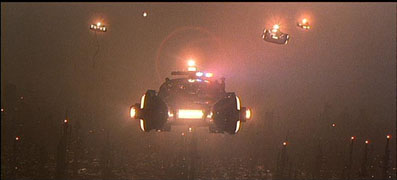 |
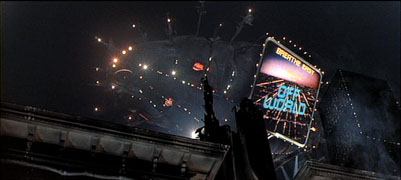 |
|
| |
Sophia Wu
Change in Transportation? Compare Blade Runner to Metropolis 1927
in this respect. Is the transportation presented in this film
more or less successful in creating a futuristic feeling? Do the
cars effectively relate to the cars of today?
In our technology boom with the increasing dominance of automobile, car is becoming a new environment. Instead of airplanes which is used as transportation in Metropolis 1927 which still seem remote. Since concept cars already exist and represents a futuristic idea for transportation, it is easier for people to adapt into and adjust to the realism of the movie.
Also it satisfy our dream of levitation for all because everyone may have the ability to own such a flying car as car culture has become more popular.
In other words, it is more accessible because cars has become environmental in our society.
The cars also effectively relate to our cars of today, in my opinion. Today many conceptual cars have under lighting which make them feel like flying. Also some concept cars have doors open like wings. They also seem very chunky and heavily mechanic, which seems not aerodynamic at all. This may not be so effective in persuading the audience if we think hard about gravitational forces. However, it may just show how inefficient the mechanics are and which corresponds to the polluted metropolis environment in the film. Maybe the metropolis is a deserted land which cannot afford to buy more efficient technology which leads to its destruction even worse, which shows some truth in developing country, or industrial cities in general.
|
|
| |
16. |
 |
 |
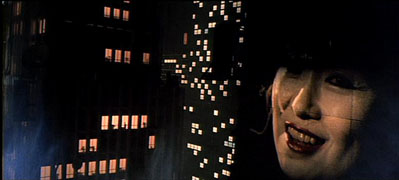 |
x |
| |
Ying Xu
How does the potential of life in an
off world colony change the presentation of a dystopic future in
this film as compared to Metropolis 1927? How does this
idea support the feelings of the dystopia as developed by the urban
nature of "life at grade" as depicted in the film?
Dystopia is known as a society – usually in a futuristic setting – that has degraded due to unhealthy and unruly advancements of technology. There would be a repressive and authoritative state in control of every aspect of the society. Initially it might appear utopian, but it is not a peaceful state in which people live in a harmonious community. It is always on guard of danger and the city is decorated with caution and warning. It is the opposite of utopia.
In Metropolis 1927, it is clearly a dystopia as people are repressed to work unreasonable amounts of hours to serve a machine, which is the “heart” of their city. Hierarchy is divided very apparently as we follow the hero, whom is the mediator, as he runs back and forth between his father – the ultimate authority – and the caves of the suppressed workers. There is constant danger that workers may be sacrificed to the machine’s appetite in order to keep it “happy” and everyone knows that there is no way out. There would have been no end to the suffering without the appearance of the mediator, whose appearance really had no assurance.
The society in Blade Runner was also dystopic as seen in the industrialized depiction of future technology and the trapezoidal architecture that stands as the authoritative power, however people’s lives seemed much more enjoyable and carefree. It is much more tangential to the society we are familiar with and each person could act freely as individuals. The reason for this is that technology has allowed the existence of an off world colony that takes the weight off the earth. It poses as a light at the end of the tunnel and a glowing spark of hope in the distance of space.
The urban nature of “life at grade”, as illustrated in the three images taken from the film, is charged by this far off world. It is advertised as ideal – ie. with beautiful smiles of women. The hovercrafts impose on the city like a heavy blanket, keeping the people happy and optimistic.
|
|
| |
17. |
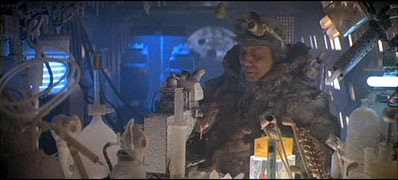 |
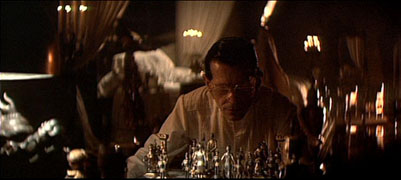 |
 |
|
| |
Yifei Yuan
How does the role of these (mad) scientists
feed into the idea of the presentation of the urban future? How do these compare with the other "mad" characters in Metropolis 1927 (Rotwang) and Things to Come?
In blade runner, Tyrell, being the leader and head designer of Tyrell Company which produces the replicants, is presented as the highest science authority and is constantly referred to by others as a genius. In addition to this he seems to be the leader in politics and other realms. He is viewed as a God-like presence. Only in his office do we see any essence of the sun and a calm space. In a new type of creation theory, it is science and technology that has created the world. The future human society is created by science and technology, and it is destroyed by the pollution of the side effect of science and technology. The scientists symbolize the future society,
In contrast to Tyrell is the scientist Chu, who is a genetic engineer of eyes. He works in the freezing basement of his shop, far away from the light and sun. He remains at the bottom of the corporate ladder, suggesting a wide network of people living in the most basic and poor environment, under the surface. Sebastian, our third scientist, lives in a large apartment, which is dark and dank. These men are middle class citizens and are portrayed as very much like the rest of those still on earth. They are struggling for lives and did not enjoy the world as much as the top class. The future world is science based and has an environment similar to consumer economics. People are divided into class and the different categories of scientist represent the structure of the society.
The mad scientists in Metropolis show similarities in which the madness is the self-destructive desire which projects into the society. Science has become something that has always been feared – the maker and destroyer of worlds, an all-powerful beast, a God. He made the female robot to destroy the human world. The scientist is the architect of the world, and advances the way of how people live in the world. But after all he and his creation is destroyed by positive qualities in humanity, which is the power of love. But in bladder runner, there is no way human can keep living if science and scientists are extinct.
In Things to come, the scientist gives a more positive images which people is actually living comfortably in the world and appreciate science. The scientist is presented as a world saver and brings people peace. The scientists and engineers are trying to create civilization out from the destruction of the war. This is similar to the beginning stage of Blade runner where everything created by advanced science only show its advantages, but as the scientific civilization grows, it may be evolving to a situation that science become the largest obstruct of civilization.
|
|
| |
18. |
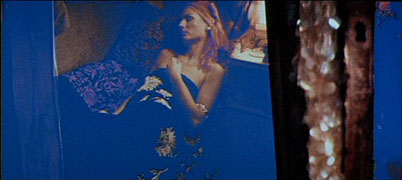 |
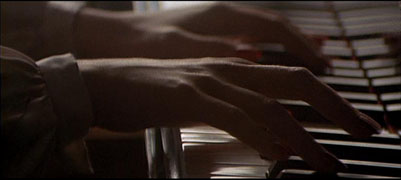 |
 |
|
| |
Jay Zhao
Posture on the role
of "art" and
artistic expression as proposed in 2019. What IS art? Does it
still have a role or purpose? If so, what is that? How does it impact the metropolis of the future?
The world depicted in bladerunner had been scarred heavily by its industrial consumption. Driven by mass consumerism, efficiency and anonymous, it accelerated the decoy of experience of the city. As a result, art was all that was left as a reminisce of human innovation. A very prominent theme of the movie was of memory. The purpose of art was to be an physical artifact of memory to an individual. These objects hold a deep experiential quality that’s lost in the other aspects of their society and thus, leaving them highly valuable to their owners due to their uniqueness.
The first image is a photograph of Zhora the snake charmer. A photograph is a effective method of capturing memory because it has the ability to tell a story and thus induce experience. The second image is of Rachael, a replicate playing the piano through implanted memories. The ability to play music gives a very expressive quality to the individual, something a replicate should not be able to do. Never can a piece of music be played exactly twice and this is what creates its authenticity. The 3rd image is of one of the toys created by J.K Sebastian, a genetic designer for the Tyrell Corporation who suffers from Methuselah syndrome. Modelled by hand, he imposes his own characteristics into his toys and become his friends. Sharing this similarity with the Nexus 6 replicates, he was also able to identify himself with them and thus befriending them.
All 3 stills are shown without the influences of industrial consumption, still very rich of tradition and experience. The metropolis of the future is concerned with the over abundance of irrelevant facts, facts that ‘merely scratch the surface’ of its real potential and usefulness, rendering it impossible to create new experiences, and thus art. Creating art is to be human. The ability to imagine and create is necessary to avoid the generic and create individuality.
|
|
| |
19. |
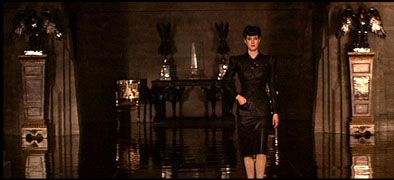 |
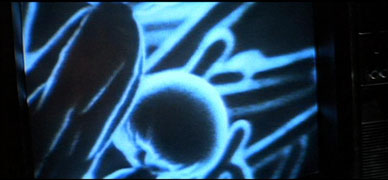 |
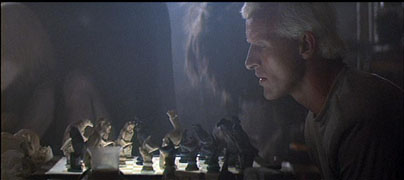 |
|
| |
Carlo Pasini
How is the role of "perfection" in
human beings translated into a similar presentation of architecture
and architectural expression in the urban and architectural environment
of 2019?
In the film Blade Runner, there are four types of perfection: emotional depth, physical beauty, and intellectual genius. These perfections are depicted in the three screen captures and are each reflected in their given environments.
The first film clip is near the beginning of the movie when Rick Deckard is invited to the Tyrell corporation, where he meets Tyrell's assistant Rachel. From the moment she walks in, Rick is taken by her perfect physical beauty. He is asked to run a Voight-Kampff test and it is revealed she is a replicant. The test is able to deduce this by her lack of true emotional pathos, based on lived childhood experiences. When she becomes aware of this news she is struck with feelings of melancholy, knowing she can never be entirely perfect. She spends the rest of the movie in Rick's apartment; filled with pictures of the past and memorabilia, it is an emotional incubator for Deckard and an environment which Rachel strives to immerse herself and share, but can only do so synthetically.
The second clip happens 1/3rd into the movie, when Rich Deckard is looking for information on a fish scale he found. He drives his car down from the elevated city to go to a street level merchants district, where replicant animals are made and sold. He finds out that the scale instead belongs to a snake. He pursues it to a nearby merchant who apparently makes the snakes. Notably, the district is of lower class, and lesser-complicated replicants species are being made. The scene is impressive for the level at which replicants are produced and integrated within society, and the depth at which the physical perfection can carries in resemblance until one zooms as far as to see the insignia bar code. Physical perfection is something that is also part of the third clip, which takes place 2/3rd the way in. Bris and Roy, the two remaining Nexus-6 replicants, are at Sebastien's house, where Sebastien remarks to them often about their physical perfection.
In that scene Roy is playing with Sebastien correspondence chess game which reflects Sebastien's inferiority-complex sentiments to the intelligence of the great Tyrell's “genius mind.” We also find out in this discussion that Sebastian has a disease that make his “glands grow old too fast.” Roy entices Sebastien on this bases to visit Tyrell at his home, as a cure would benefit the both of them. The elevated skyscrapers of the Tyrell corporation represent the new and overseeing intelligence with their pyramid-like expressions; while in contrast, the Bradbury Building, where Sebastien keeps all his lasting toy creation, represents the old, insecurity of disease. This contrast is there to represent the overarching desire for perfection in human that is unattainable: living forever. Without this, none of the other three are meaningful. The siege of the Bradbury building and its “Menagerie” at the end of the film can be translated as the struggle with this notion being the most consuming to the human psyche.
|
|
| |
20. |
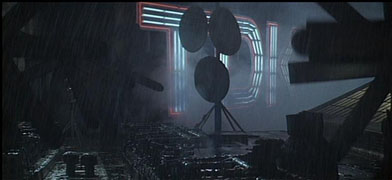 |
 |
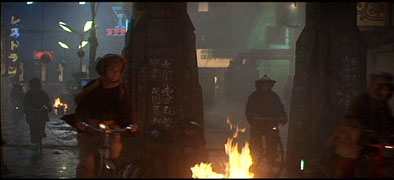 |
|
| |
Nicholas Savage
Comment on the use of decay in buildings
as it relates to the plot, setting and significance of the associated
parts of the films. How does this feed into the idea of the metropolis of the future? Is it believable?
|
|
| |
21. |
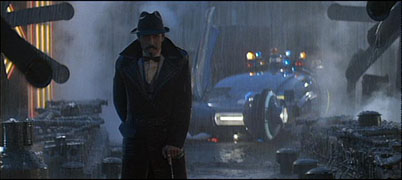 |
 |
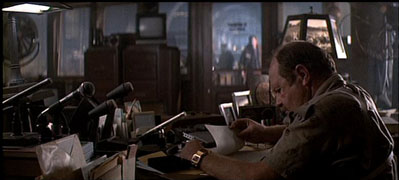 |
|
| |
Nicole Bruun-Meyer
Comment on the role
of the "police" and
authority in the proposal for 2019. Is this appropriately represented
in the architectural setting and technology associated with "authority"?
How does this relate to the portrayal of authority figures in
Metropolis and Things to Come? How does this play into the believability of the portrayal of the metropolis of the future?
The future, according to Ridley Scott’s Blade Runner, is bleak! Civilisation has turned into a panopticon-like state, with a distinct segregation of social class. There is definitely a strong theme of authority in this film, however it does not come from the assumed role of the police force. While the citizens of the 21st-century Los Angeles depicted in the film are constantly monitored and tracked by police vehicles that hover above them, the real group that controls the city is the Tyrell Corporation.
The film makes this clear in a number of ways. First off, the image of the police and their headquarters is reminiscent of the film noir genre, a frumpy and disorganised space that hardly fills the audience with confidence in their authority. It is quite strongly juxtaposed against the monumental architecture of the Tyrell Corporation building. While the rain always falls on the lower class of the city, the pyramid-shaped offices and home of Mr. Tyrell stand above the clouds. The style and opulence of the structure suggest it plays a more dominant role in the futuristic society then the police headquarters.
In William Fischer’s article, he discusses the role of the costumes within the film and how they portray authority. He states.
The film's costume design, for example, bespeaks transgression-the aberrant, the bizarre, the arbitrary-but of a highly codified sort whose force derives from the dispersal of the traditional signs of power into style: the black leather jacket, the SS boots, the padded shoulders and wasp waist. Authority has been displaced; it appears in the guise of a set of cultural symbols that is fashion. To don these symbols is to put on authority, which has lost its central seat in the form of the police, the state, big business- who are forced in their turn to resort to a symbolic show of power in the form of monumental, brutal, or grotesque design (the Tyrell pyramid, the police uniforms).(Fischer, pp.194)
The police force has become a symbol of authority, rather then an actual authoritative figure. As Chevrier points out, he Blade Runner, or Bounty Hunter, “performs its function among general indifference: the cop (whom we know from inside thanks to the voice-over narrative) feels like an underdog.”(Chevrier, pp. 56) On the other hand, the Tyrell Corporation has a vision for the city and has become almost dictatorial in its production of this vision.
In a way this is similar to the vision Rotwang has in Metropolis, in which he sees himself as the creator and architect of a future society in which he believes. The real authority figures, such as the police, as over-ruled by these creations and in the end become their own destroyers. The evil Maria begins to manipulate and control the workers and members of the middle-class in order to turn them against each other. Contrarily, the Replicants in Blade Runner really only want a way to extend their lives, it is only the ‘authority’ that has deemed them a danger and in need of termination.
In all three films, Blade Runner, Metropolis and Things To Come, the organization and architecture of the futuristic cities indicates societies full of hierarchies. The authorities are always high above, looking down. They are also systems where a few select individuals have decided the fate of the many. In Things To Come, the authorities of Future Everytown want to push ahead with technology and progress, as seen in their attempt at reaching the moon. Meanwhile, the citizens have had enough of this constant drive to expand and revolt, trying to destroy the space shuttle. Blade Runner is the only film that primarily does not involve the regular people of the city, who are mostly unaware of the actions of the Replicants.
Seeing these films at a time in history, where most countries are ruled by a democracy, it is hard to believe that such futures could ever exist. How would such discrepancies in classes and levels of authority be allowed to happen? As long as societies have people to keep it in check, such futures should not come to be. In the case of Things To Come, it is a world disaster, the never-ending war, which triggers this shift in power, and as many predict, it would be this same type of event, which would shift the worlds super powers and in so doing, shift the authorities in those societies. In terms of the architecture of the future, we are already, in many places, having a backlash against the rising towers of the city. The idea that we will be watched from above is more appropriately seen in the surveillance on the streets, rather then high above us.
Bibliography:
Bruno, Giuliana. “Ramble City: Postmodernism and Blade Runner”. October, vol. 41. Summer 1987, pp. 61-74
Chevrier, Yves et al. “Sociology of Anticipation”. Science Fiction Studies, vol. 11, no. 1. March 1984, pp. 50-60
Fischer, William. “Of Living Machines and Living-Machines: Blade Runner and the Terminal Genre”. New Literary History, vol. 20, no. 1. Autumn 1988, pp.187-198
|
|
| |
22. |
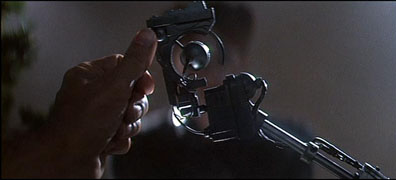 |
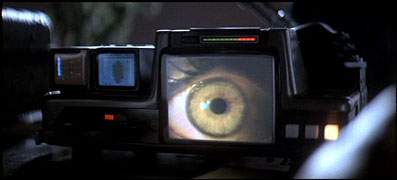 |
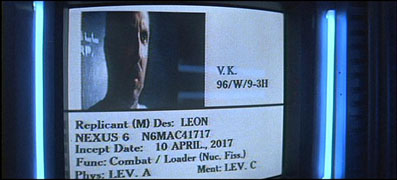 |
|
| |
Andrea Nagy
If the motto for Tyrell is "more human
than human", and human beings are the most vulnerable in their
expressions of the eye, why would the eye be chosen to be the telltale
sign of a replicant? Is this not a contradiction?
In Ridley Scott’s Blade Runner, Tyrell designs his replicants to imitate humans in every way except for their emotions. In doing so, he creates creatures that can act autonomously and carry out specific tasks for which they have been programmed. However, proclaiming that the replicant is “more human than human” is obviously not a fully accurate statement because it conveniently ignores the fact that the basic distinguisher between a human and a machine is the presence of a consciousness, and thus emotion, which often manifests itself through specific eye movements. It is a convenient oversight in that it allows Tyrell to control the replicants without the fear of any reprisal from creatures who, for all intents and purposes, should not feel marginalized or abused by such negative treatment. Steven Sanders reveals the irony of the situation in asking, “Why should beings who are ‘more human than human’ be treated as slaves and forced into demeaning labour and violent actions on behalf of the actual humans who created them?”
When exposed to emotional stimulus, humans generally experience a range of physical reactions that manifest in a number of different ways. In measuring empathetic reaction, various biological responses such as fluctuations of the pupil and involuntary dilation of the iris will occur in human test subjects. Through the Voight-Kampff machine’s analysis of eye movement, the Tyrell Corporation can easily determine what constitutes for a normal human empathetic reaction. In choosing the eye to be the telltale sign of a replicant, Tyrell is essentially acknowledging, and at the same time capitalizing on, the emotional limitations of his replicants. The declaration that the replicant is “more human than human” seems to primarily be a marketing slogan rather than an accurate portrayal of the replicants’ capacities. In reality, while the replicant may be able to compete and even surpass the human being on multiple levels, it falls short of acquiring the very thing that perhaps best encapsulates the essence of humanity, the ability to feel emotion. The eyes, which are commonly said to be the windows to the soul, will continuously reveal the true nature of the test subject and area testaments to the unique and ineffable qualities that separate man from machine.
Why would Tyrell apply such an intrinsically contradictory motto to his replicants? Unless one refers directly to the topic of emotion, the argument that replicants are “more human than human” is essentially true, as replicants are equal or superior to humans in every other way. However, the irony of Tyrell’s proclamation lies in the fact that no replicant can truly be more human than human unless it masters ALL human traits, specifically the ability to experience and demonstrate emotional responses. On one hand, the statement reflects Tyrell’s desperate ambitions to perfect or better the human being. On the other hand, it might also signify a fear-based reaction on Tyrell’s part, in response to the possibility that his replicants may in fact develop their own emotions after a number of years. In other words, despite the fact that the empathy test is successful in detecting replicants at present, perhaps Tyrell’s phraseology reflects his belief that this may not necessarily be the case for much longer. It is not surprising then that, as a precaution, Tyrell built in a fail-safe device that automatically deactivates any replicant four years after its initialization.
The notion that the eyes ‘give a replicant away’ is further emphasized by the prominent glowing retinas the audience sees in a number of replicant eyes throughout the film. Symbolic of artificiality, the red glow furthers the idea that regardless of any and all physical similarities, Tyrell is as of yet unable to program his replicants to fully and authentically experience emotion, at least not to the same degree that humans do. If they did, the result would be a human-like response to stimulus, as observed through the various fluctuations and dilations of the eye. However, with that being said, there is no doubt that the new generation of replicants, as epitomized by Roy, has the capacity to experience some form of rudimentary cognition and emotion. There is evidence of this near the end of the movie, particularly in the climatic rooftop scene in which Roy chooses to save Deckard’s life rather than let him fall to his death. The Nexus-6 replicants are as of yet unable to manifest any rudimentary emotions they may have in a human-like manner and the possibility exists that they may never manifest emotion in exactly the same way the humans do, regardless of further advances in genetic engineering. Ultimately, the question becomes: Do they really need to?
Sources:
Blade Runner
http://www.scribd.com/doc/40142027/Philosophy-Science-Fiction (p. 27-28, What is it to be human?)
http://en.wikipedia.org/wiki/Voight-Kampff_machine
http://bladerunner.wikia.com/wiki/Themes_in_Blade_Runner#Eyes_and_memories
|
|
|
23. |
 |
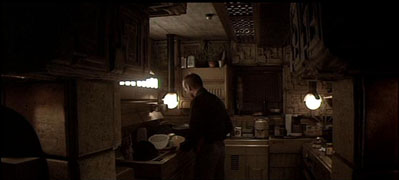 |
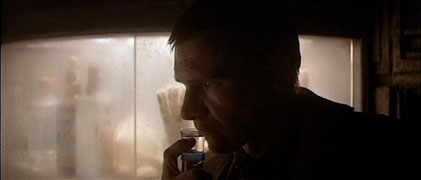 |
|
| |
Sophia Zhu
There has long been speculation in the
many versions of this film that Deckard is also a replicant. Cite
instances from the film to SUPPORT this claim. How is this important to the idea of the metropolis of the future?
In Blade Runner, Replicants are perfect beings created by Dr. Tyrell. They are virtually identical to an adult human, but have superior strength, agility, and variable intelligence governed by their projected functions. All Replicants are slaves to humanity and their individual functions are specific to them: combat, labour, or pleasure, etc. Because they so similar to humans, the only differences are their innately embedded memories and their short life span of merely four years. There has long been speculation in the film that the protagonist Deckard is also a Replicant. Fitting many traits that define a Replicant, there are many instances throughout the movie suggesting Deckard is indeed one of them.
Throughout the film, Deckard is followed by a member of the police force Gaff who is been detailed to watch him, keep him in line, see that he Does His Duty and so forth. Gaff folds origami animals out of chewing-gum wrappers and like substances and then scatters them about so that Deckard knows that he, who is tracking the Replicants, is himself being tracked. At the very end of the movie when Deckard comes home after the epiphany, picks up Rachael, and just before going away with her forever, sees the glint of silver-foil on the floor. He picks it up and discovers that it is a silver origami unicorn. At that moment, Deckard is aware that he is been watched just like every other Replicants. This scene is especially significant in hinting that Deckard is one of the Replicants in conjunction with the dream sequence happened in the earlier part of the film. Lost in thought while playing the piano, Deckard has dreamt a vision of a unicorn galloping through a forest. Seeing the unicorn again in the form of Gaff’s signature origami piece, the viewer is immediately aware that Gaff knows what Deckard is thinking, suggesting that like Rachael who is “more human than human” his thoughts and memories have been created for him. Every memory and dream a Replicant has is known to the creator. The fact that Gaff knows Deckard dreamt of a unicorn implies that Gaff knows what dreams Deckard has been implanted with; therefore, suggesting Deckard is a Replicant.
Replicants possess superior physiques, strength and agility than human, which make them excellent fighters. One would have no doubt that it would be a very difficult and extremely dangerous task for a real human being to fight the Replicants and even to kill them. There are many battle scenes throughout the film between Deckard and the Replicants. It is rather impressive that Deckard survives the beatings and even manages to exterminate all of them. These scenes give an impression that Deckard have abilities equal or even superior than that of a Replicant, which makes the viewers question, is he human? Furthermore, understanding how precious life is, the police would not risk a real human to hunt such dangerous beings. Knowing that Deckard is constantly followed by the police Gaff and he possesses inhuman strength, it is not hard to suspect that Deckard is a Replicant created with the function of hunting other Replicants; and Gaff is the real Blade Runner behind the scene. In addition, the head police Captain Bryant’s threat “If you’re not a cop, you’re little people” gives an allusion to Deckard being created solely for police work.
Replicants have a special attachment to photographs, because it gives them a tie to their non-existent past. Photographs capture a moment in time and freeze that instant, but in the movie they are used to enforce the false and forged memories rather then preserving a moment in time. Deckard's apartment is packed with photos of what seem to be friends and family, but none of them are recent or in color, and the fact that he is in none of them shows no evident of any ever existed in reality. This raises the question of Deckard’s state of being and if he is actually human. Photographs are common to find in a home, which makes his apartment feel more comfortable; however, at the same time, the idea of false memories is very prevalent in the movie and seeing the abundance of photos immediately makes the viewers question their validity—are they real or forged by the creator? Just like Rachael needs a photo as an emotional cushion, Deckard too shows a strong attachment to his photos in his home. It is this attachment gives hints that Deckard too is a Replicant.
Another instance suggesting Deckard is a Replicant is the glow in the eyes. Eyes are the one tell tale sign of a Replicant. In several scenes, Deckard’s eyes have a yellowish orange glow. Not sure if it is the reflection of the sunset, but the glow is particular to Replicants. Within the same scene, the eyes of real humans remain the same. As a result, the speculation of Deckard as one of them is made concrete.
The speculation that Deckard is a Replicant is very important to the idea of the metropolis of the future, because the integrity of humanity is questioned and the metropolis is evolving based on the nature of humanity. In the film, we learn that who appears to be human is actually not. For instance, Rachael who is “more human than human” finds out she is not, even though she believed her whole life that she is one. It is also extremely shocking when many instances point to the fact that the main character, the Blade Runner Deckard might also be one of the artificial beings. Due to such shocking find, the viewers no longer know who is real and who is not. Looking around the city, no one can be trusted. The Replicants are created as slaves to human. The dehumanizing nature is well reflected in the depiction of the metropolis—the city is always dark, smoky and rainy, no one sees daylight. In addition, the Replicants only have a four-year life span. If everyone or majority of the inhabitants in the city are Replicants, the metropolis will indeed going through never-ending cycles of recycling and evolving as the old Replicants disappear and new ones rise. The future metropolis is shown as being constantly layered, repaired, the new structures are building on top of the old, and is continuing to evolve. Furthermore, the movie has a very dystopic view of the future as the buildings are all very empty yet the streets are very crowded with animated street life. The emptiness of the buildings reflects the ephemeral nature of the life of the artificial beings, and the active street life becomes a kind of a hologram, a ghost image, an illusion that everyone is living. “It's too bad she won't live; but then again, who does?”
REFERENCE
Kerman, J. B. Retrofitting Blade Runner. Madison, Wisconsin: The University of Wisconsin Press, 1997.
http://tvwiki.tv/wiki/Blade_Runner
http://hem.passagen.se/replikant/
http://www.blade-runner.it/
http://www.filmsite.org/blad.html
http://en.wikipedia.org/wiki/Blade_Runner
http://www.imdb.com/title/tt0083658/
|
|
| |
|
|
|
|
|
| x |
|
|
|
|
|
